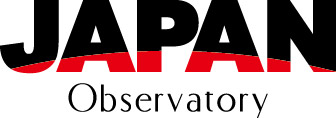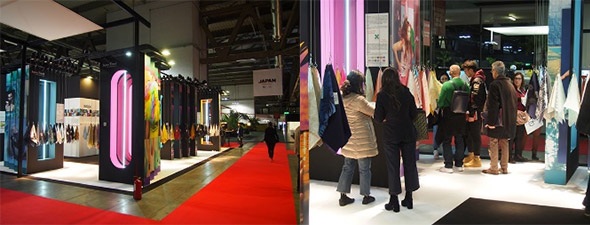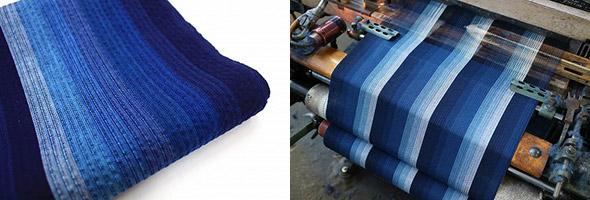

Photo:The Japan Observatory at MU2020SS |

< Milano Unica (MU) 2021SS > will be held at Rho Fieramilano, in Milan, Italy. from 4-6 Feb. This MU fair - Milano Unica 2021SS - will feature the participation of < The Japan Observatory > (observing Japan), co-organized by JFW and the Japan External Trade Organization (JETRO), on a scale of 30 companies/associations. |
| |
Period: 4-6 Feb. 2020
Organiser: Milano Unica Secretariat
Venue: Rho Fieramilano |
“The Japan Observatory” at Milano Unica 2021SS |
| |
Organisers |
: |
Japan Fashion Week Organization(JFW)
Japan External Trade Organization (JETRO) |
| |
Support |
: |
Ministry of Economy, Trade and Industry (METI)
Japan Textile Federation (JTF) |
| |
Overall structure |
: |
Exhibitors’ booths + JAPAN PR booth |
| |
No. of exhibitors |
: |
30 companies/groups |
| |
Venue |
: |
Rho Fieramilano < within Hall.12 > |
< Milano Unica (MU) 2021SS > will be held from February 4-6, 2020 at Rho, Fieramilano in Milan, Italy. The Japan Observatory at Milano Unica 2021SS, co-organized by the Japan Fashion Week Organization (JFW) and Japan External Trade Organization (JETRO), will also participate. The total number of exhibitors will be 30 and we are delighted to introduce new exhibitors at Milano Unica. |
ASAHI SENSHOKU CO., LTD. Sol Levante 1918 |
A stand-out passion for hand-printing |
ASAHI SENSHOKU CO., LTD. from Ashikaga City in Tochigi Prefecture is set to make its debut at Milano Unica. Ever since its founding over a century ago (102 years), the company has been honing and nurturing its hand-printing expertise and technique. Although hand-printing is time-consuming and costly, it remains feasible for smaller batches, which is why inkjet printing has recently become mainstream. However, they insist on hand-printing which involves ordering printing paste from overseas for original blending. Moreover, dyeing is done by artisans using colours that are individually blended and naturally dried without machines – in other words, using solely human hands and the power of nature. They participate in the fair to bequeath techniques to the next generation. Company President, Mr. Masatoshi Tanabe, is fluent in Italian language thanks to a year spent training in Como, Italy in his youth and comments; ‘We intend to showcase our fabrics to European luxury brands.’
They plan to showcase < Sol Levante > as part of their design proposals and production sales business. This is a ‘made-to-order’ collection, based on a vast array of 40,000 registered pattern designs and the company is enthusiastic about ‘expanding the scope of design proposals in Europe as a business putting forward and producing designs.’
|

Showcasing fabrics including recycled cotton |
ENMAGO SYOKUFU CO., LTD., from Nishiwaki City in Hyogo Prefecture has been exporting via trading companies to date, with no exhibiting experience at overseas fairs and Milano Unica will mark their inaugural overseas participation. They eagerly comment as follows: ‘Despite our lack of overseas experience, we have been proceeding to prepare with regional support and look forward to seeing the response to our fabrics with our own eyes’ as they take on the challenge and join the initiative.
They produce jacquard woven fabrics, featuring rich expressiveness and a collection which, this time around, centres mainly on cotton fabrics, for spring and summer. While they normally use cotton for warp and polyester/Tencel for weft, they will showcase fabrics using recycled cotton, reflecting an increasing trend toward sustainability in Europe, alongside dress fabrics with an elegant and lustrous feel sealed in by mercerized finishing; using even 100% cotton and items treated with silk protein for a softer and skin-friendlier texture, rather than for moisturizing purposes. They intend to ‘bring in their yarn-sample book to the venue,’ although their business is basically made-to-order production.’ |

Supporting exports of fabrics originating from local textile regions |
‘Third party logistics’ is a logistics term, meaning to undertake and execute logistics operations. 3rd. PARTY LLC, located in Shibuya Ward in Tokyo, is a converter/trading firm/wholesaler, that contracts with several regional weavers in Japan and deals with overseas companies that help export Japanese fabrics overseas by establishing showrooms in the United States and China (Shanghai). They are targeting the European market by joining Milano Unica for the first time.
The company points out the following: ‘There are many barriers for local weavers/makers to export; from making all the necessary documents for shipment to negotiations in local languages. There are also cases in which business ends after obtaining sample orders for fair participation, which is why we prioritize how to follow up after participation in fairs.’
On this occasion, they showcase fabrics featuring the major textile regions in Japan: BISHU, HOKURIKU, OKAYAMA and HIROSHIMA and anticipate ‘the reaction of the European market.’ |
Presenting eco-dyeing techniques |
SAKAMOTO DENIM CO., LTD. from Fukuyama City, Hiroshima Prefecture participates in a joint booth, <JAPAN DENIM> at Milano Unica. They focus on denim fabrics using indigo-dyed warp yarns and intend to promote colour variations representing their dyeing technique at the fair this time.
The company has also attracted attention for its ‘eco-dying technique’: rope dyeing generally requires warm water and chemical detergent, whereas this company uses room-temperature water for dyeing, which helps save energy. Furthermore, they strive to reduce detergent in their production processes by generating strongly alkaline electrolyzed water by electrolyzing while cleansing and dissolving salt in water for a higher cleansing effect, alongside strongly acidic electrolyzed water retaining bleaching, anti-bacterial and colour-fixing effects. ‘This technique was developed around seven years ago and is now 100% stable, although the colours were initially unstable. It has started attracting attention as a means of sustainable denim production,’ according to their comment. Their denim fabrics are certified as the local ‘FUKUYAMA BRAND.’ |

NAGAO ORIFU UNLIMITED PARTNERSHIP |
Introducing ‘SHIJIRA-ORI’ |
NAGAO ORIFU from Tokushima City, Tokushima Prefecture are making their debut in a large-scale overseas exhibition. ‘We intend to propose Japanese textile by adding western elements and seeing how they are evaluated overseas – ultimately with the aim of harnessing this experience in our forthcoming product development,’ they comment, regarding their motivation.
On this occasion, they showcase ‘AWA SHIJIRA-ORI’ (SHIJIRA WEAVE), boasting 120 years of history and said to have been originally designed and invented by a female weaver residing in Atake Village in AWA; inspired by the uneven crimpy surface of a fabric having shrunk after being drenched in the rain. The SHIJIRA-ORI fabric with its particular crimped texture and light and cool-feel cotton fabric has particular charm and retains high water absorbency. Their line-ups also include cotton items using organic cotton as a sustainable line-up alongside light/sheer fabrics resembling ‘RO’ or ‘SHA’ materials (gauze/silk gauze) by partly removing weft yarns.
AIZOME (indigo-dyed) fabrics are familiar to Japanese people and sustainable by nature. Fabrics using natural indigo provide profound and stable colours gradually obtained by washing, which will also be showcased alongside. |

KAMEDA TEXTILE COOPERATIVE SOCIETY
(TACHIKAWA TEXTILE MANUFACTURE / NAKAEI TEXTILE) |
Promoting ‘KAMEDAJIMA’ (KAMEDA STRIPES) |
KAMEDA TEXTILE COOPERATIVE SOCIETY (TACHIKAWA TEXTILE MANUFACTURE / NAKAEI TEXTILE) from Niigata City, Niigata Prefecture will be promoting their local brand: ‘KAMEDAJIMA’ (KAMEDA STRIPES). The ‘KAMEDAJIMA’ has a history dating back over three centuries and is a traditional Japanese textile woven in graceful traditional tonality originating from the Edo Period, which remains soft and durable. The colouration derives from the beauty of nature; namely seasonal flowers, plants, butterflies and birds found in nature, as used for clothing. Multiply layered colours create a united harmonious ambience while mutually complementing each tone.
‘To date, we have been showcasing our fabrics in New York, Shanghai and Hong Kong and we are looking forward to how Europe reacts – with no idea at present,’ they explain what initially spurred them to participate in Milano Unica. The KAMEDAJIMA was once interrupted, but past materials have been retrieved and a reproduction project has been underway for some 15 years. A permanent corner for KAMEDAJIMA has been set up within Niigata Airport and a regional collective trademark was also acquired by the Patent Office in 2014. They hope to promote KAMEDAJIMA, applicable to wide-ranging items from clothing fabrics to other various items to Europeans prior to the Tokyo Olympic Games, given the many foreign tourists expected to visit Japan on that occasion. |

|







